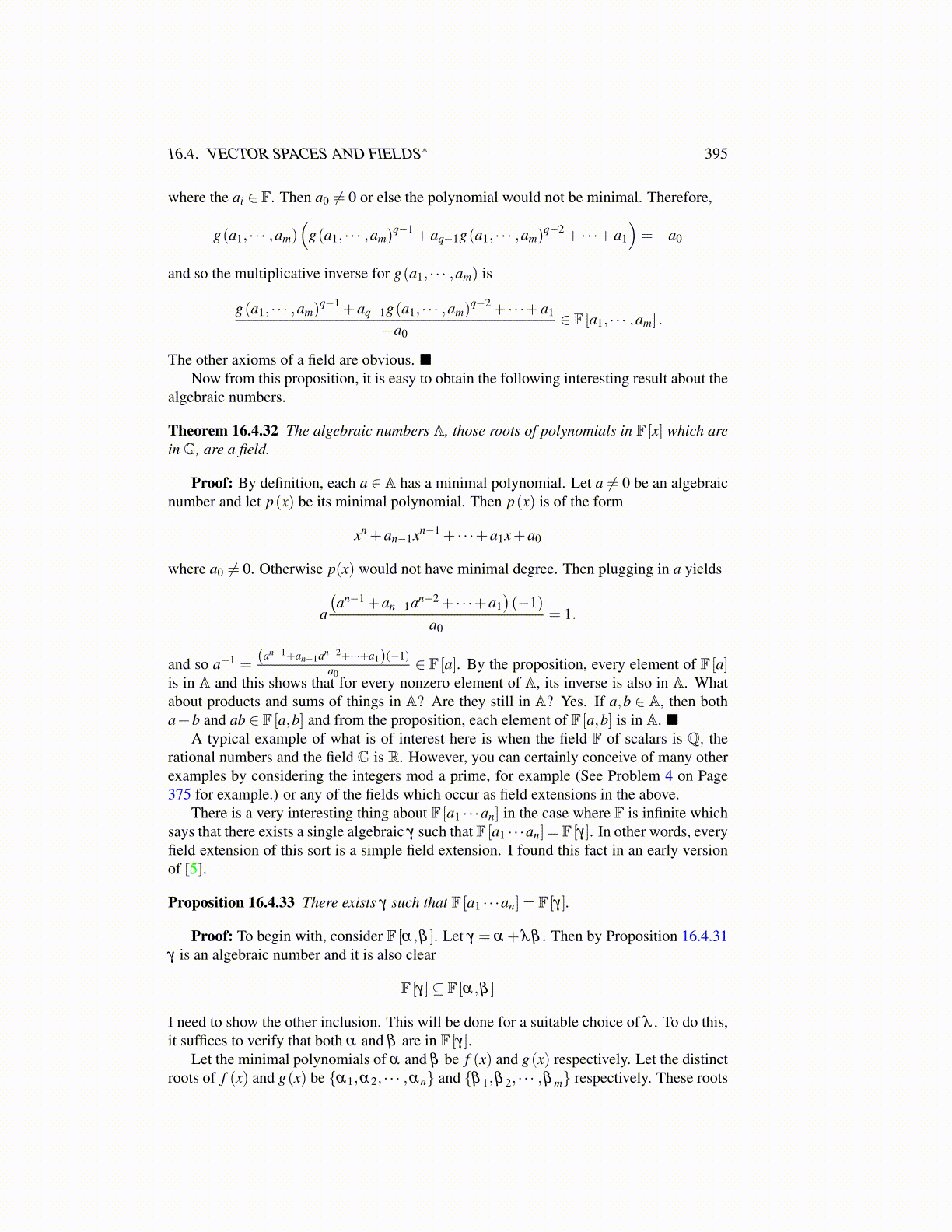
16.4. VECTOR SPACES AND FIELDS∗ 395
where the ai ∈ F. Then a0 ̸= 0 or else the polynomial would not be minimal. Therefore,
g(a1, · · · ,am)(
g(a1, · · · ,am)q−1 +aq−1g(a1, · · · ,am)
q−2 + · · ·+a1
)=−a0
and so the multiplicative inverse for g(a1, · · · ,am) is
g(a1, · · · ,am)q−1 +aq−1g(a1, · · · ,am)
q−2 + · · ·+a1
−a0∈ F [a1, · · · ,am] .
The other axioms of a field are obvious. ■Now from this proposition, it is easy to obtain the following interesting result about the
algebraic numbers.
Theorem 16.4.32 The algebraic numbers A, those roots of polynomials in F [x] which arein G, are a field.
Proof: By definition, each a ∈ A has a minimal polynomial. Let a ̸= 0 be an algebraicnumber and let p(x) be its minimal polynomial. Then p(x) is of the form
xn +an−1xn−1 + · · ·+a1x+a0
where a0 ̸= 0. Otherwise p(x) would not have minimal degree. Then plugging in a yields
a
(an−1 +an−1an−2 + · · ·+a1
)(−1)
a0= 1.
and so a−1 =(an−1+an−1an−2+···+a1)(−1)
a0∈ F [a]. By the proposition, every element of F [a]
is in A and this shows that for every nonzero element of A, its inverse is also in A. Whatabout products and sums of things in A? Are they still in A? Yes. If a,b ∈ A, then botha+b and ab ∈ F [a,b] and from the proposition, each element of F [a,b] is in A. ■
A typical example of what is of interest here is when the field F of scalars is Q, therational numbers and the field G is R. However, you can certainly conceive of many otherexamples by considering the integers mod a prime, for example (See Problem 4 on Page375 for example.) or any of the fields which occur as field extensions in the above.
There is a very interesting thing about F [a1 · · ·an] in the case where F is infinite whichsays that there exists a single algebraic γ such that F [a1 · · ·an] =F [γ]. In other words, everyfield extension of this sort is a simple field extension. I found this fact in an early versionof [5].
Proposition 16.4.33 There exists γ such that F [a1 · · ·an] = F [γ].
Proof: To begin with, consider F [α,β ]. Let γ = α +λβ . Then by Proposition 16.4.31γ is an algebraic number and it is also clear
F [γ]⊆ F [α,β ]
I need to show the other inclusion. This will be done for a suitable choice of λ . To do this,it suffices to verify that both α and β are in F [γ].
Let the minimal polynomials of α and β be f (x) and g(x) respectively. Let the distinctroots of f (x) and g(x) be {α1,α2, · · · ,αn} and {β 1,β 2, · · · ,β m} respectively. These roots